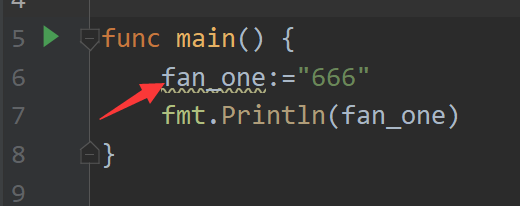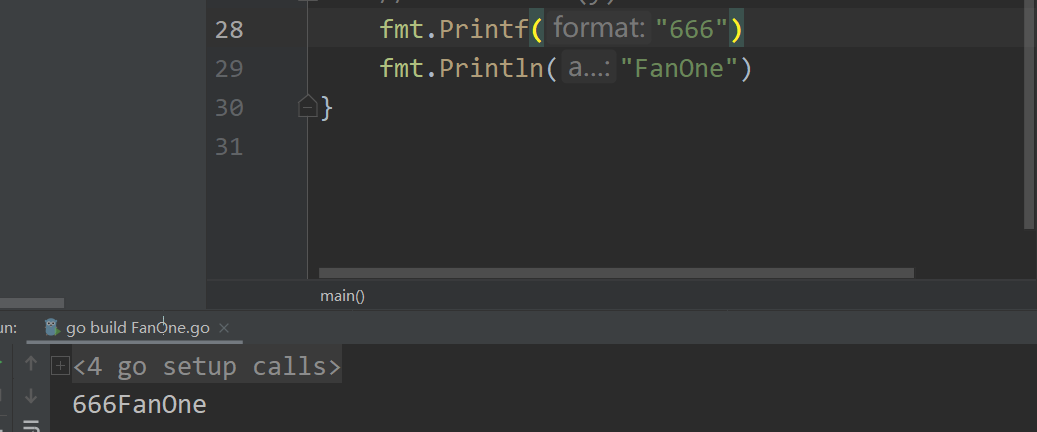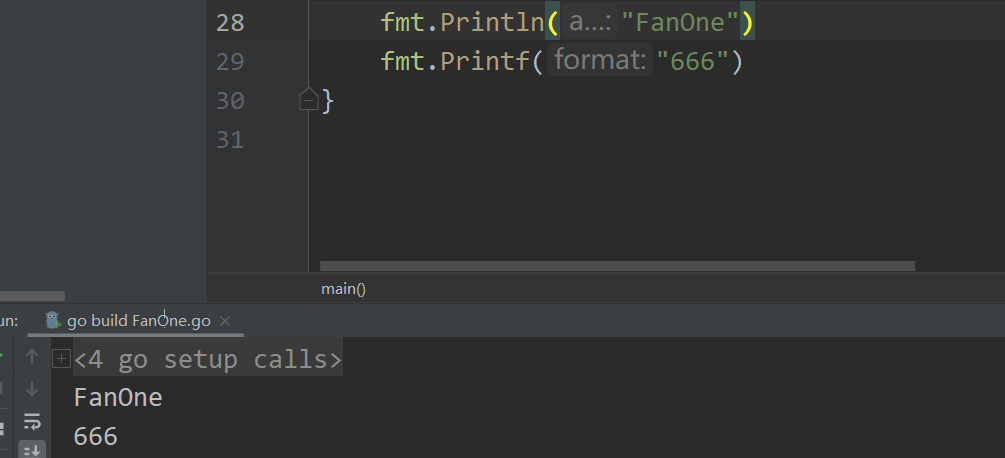
1. Program structure
1.1 name
If an entity name is declared in a function, it is only valid locally in the function. If declared outside the function, it will be visible to all source files in the package.
The case of the first letter of an entity determines whether its visibility spans packages. If the name starts with a capital letter, it is exported, which means that it is visible and accessible to outsourcing and can be referenced by other programs outside its own package.
Capital is OK!

No!

And Go language often uses hump style naming
func main() {
FanOne := "666" //Large hump (note! Generally, small humps and local variables are used inside functions. Large humps are generally used for function naming and need to be exported externally)
fanOne := "666" //Small hump
}
Of course you can use underline, for example, but I still prefer hump style~

1.2 declaration
go language can declare variables through var
var variable name type
For example:
func main(){
var fanOne string
var xiaoSheng int
var a,b,c = true , 6.6 , "fanOne" //bool ,float , string
}
Of course, you can also use:=
for example
func main(){
fanOne:="666" //String string
xiaoSheng := 666 //int integer
a,b,c := true , 6.6 ,"fanOne" //bool ,float , string
}
1.3 notes
Can use
//Single-Line Comments /* multiline comment */
1.4 single and double quotation marks
func main(){
var d rune
d = '1'
a := 'a'
b := "a"
c := `'a'':"b"` //You can enclose single quotation marks and double quotation marks
fmt.Printf("%T\n",d) // int32
fmt.Printf("%T\n",a) // int32
fmt.Printf("%T\n",b) // string
fmt.Printf("%T\n",c) // string
}
1.5 output
//Println comes with line feed Printf formatted output


2. Data type
2.1 integer
Integer data can be divided into two types, signed and unsigned
-
Signed: int, int8, int16, int32, int64
-
Unsigned: uint, uint8, uint16, uint32, uint64, byte
In addition, rune is an alias of int32
Under the condition of ensuring the correct operation of the program, try to use the data type with small space
- The difference between integers with different digits is that it can save the size of the integer number range;
- Signed types can store any integer, while unsigned types can only store natural numbers
- The sizes of int and uint are related to the system. A 32-bit system represents int32 and uint32. If it is a 64 bit system, it represents int64 and uint64
- byte, similar to uint8, is generally used to store a single character
2.2 floating point
There are float64 and float32
- The accuracy of float64 is more accurate than that of float32
- If we want to save a high-precision number, we should choose float64
The storage of floating-point type is divided into three parts: sign bit + exponential bit + trailing digit. In the storage process, the precision will be lost
The float type of Go defaults to float64
2.3 plural
There are complex64 and complex128, which are respectively composed of float32 and float64. The built-in complex function creates the complex according to the given real part and imaginary part, while the built-in real function and img function extract the real part and imaginary part of the complex respectively:
var x complex128 = complex(1,2) //1+2i var y complex128 = complex(3,4) //3+4i fmt.Println(x*y) //-5+10i fmt.Println(real(x*y)) //-5 fmt.Println(imag(x*y)) //10
Of course, we can do the same
x := 1 + 2i y := 3 + 4i
2.4 Boolean
There are only two possibilities: true or false
var fanOne true var xiaoSheng false
2.5 string
func main(){
s:="FanOne"
fmt.Println(len(s)) //6
fmt.Println(s[:3]) //Fan
fmt.Println(s[1],s[2]) // 97 110
}
String splicing
func main(){
s:="FanOne"
b := "666"
y := s + b
fmt.Println(y) //FanOne666
}
String to int
num,err:=strconv.Atoi("666")//num is an integer
int to string
str := strconv.Itoa(666) //str is a string
2.6 constants
const a = 666 fmt.Println(a) //666
2.7 array
var a [3]int //Array of 3 integers
for i , v := range a {
fmt.Println(i,v)
}
var fan [3]int{1,2,3}
var one [3]int{1,3}
t := [...]int{1,2,3} //ellipsis
fmt.Printf("%T",t) //[3]int
The length of array in go language is fixed, so array has its limitations in some scenarios
The existence of slice solves the problem of limited array length. Slice can be regarded as an array that can be automatically expanded, but it is still different from array.
2.8 slicing
You can create and initialize slices by making or slice literal, or directly create slices by using existing arrays or slices (reference types (slice, map, chan) in Go language cannot be initialized with new).
When using make, you need to pass in a parameter to specify the length of the slice. If only the length is specified, the capacity and length of the slice are equal. You can also pass in two parameters to specify the length and capacity respectively. It is not allowed to create slices with a capacity less than the length.
// If make passes in only one parameter specifying the length, the capacity and length are equal. The following output: "len: 10, cap: 10"
s := make([]int, 10)
fmt.Printf("len: %d, cap: %d\n", len(s), cap(s))
// make incoming length and capacity. The following output: "len: 10, cap: 15"
s := make([]int, 10, 15)
fmt.Printf("len: %d, cap: %d\n", len(s), cap(s))
// It is not allowed to create slices with a capacity less than the length. The following statement will report an error when compiling: "len larger than cap in make([]int)"
s := make([]int, 10, 5)
The slice is declared by the slice literal.
// The slice is declared by literal, and its length and capacity are 5. The following output: "len: 5, cap: 5"
s := []int{1, 2, 3, 4, 5}
fmt.Printf("len: %d, cap: %d\n", len(s), cap(s))
// The index can be used to give the required length and capacity when declaring the slice.
// Create a slice with a length and capacity of 100 by specifying an element with an index of 99
s := []int{99: 0}
The method to create a slice based on an existing array or slice is: s: = basestr [low: high: max], low specifies the start element subscript, high specifies the end element subscript, and max specifies the element subscript to which the slice can grow. These three parameters can be omitted. Low omission starts with subscript 0 by default, high omission is the subscript of the last element by default, and max omission is the capacity of the underlying array or slice by default (note that max cannot be less than high here). In this way, the calculation method of slice length and capacity is:
len = hith - low
cap = max - low
s1 := baseStr[1:3:10]
fmt.Printf("len: %d, cap: %d\n", len(s1), cap(s1)) // len: 2, cap: 9
s2 := baseStr[1:3]
fmt.Printf("len: %d, cap: %d\n", len(s2), cap(s2)) // len: 2, cap: 9
s3 := baseStr[:3]
fmt.Printf("len: %d, cap: %d\n", len(s3), cap(s3)) // len: 3, cap: 10
ss1 := s1[2:5]
ss2 := s1[3:8]
fmt.Printf("len: %d, cap: %d\n", len(ss1), cap(ss1)) // len: 3, cap: 7
fmt.Printf("len: %d, cap: %d\n", len(ss2), cap(ss2)) // len: 5, cap: 6
Add can use append
// Create an integer slice
// Its length and capacity are 5 elements
slice := []int{1, 2, 3, 4, 5}
// Create a new slice
// Its length is 2 elements and its capacity is 4 elements
newSlice := slice[1:3]
// Use the original capacity to allocate a new element
// Assign a value of 60 to the new element
newSlice = append(newSlice, 6)
fmt.Printf("slice: %v\n", slice) // slice: [1 2 3 6 5]
fmt.Printf("newSlice: %v\n", newSlice) // newSlice: [2 3 6]
2.9 map
A Map is an unordered collection of key value pairs. The most important point of Map is to quickly retrieve data through key. Key is similar to index and points to the value of data.
Map is a collection, so we can iterate it like iterating arrays and slices. However, the map is unordered, and we cannot determine its return order, because the map is implemented using a hash table.
Statement·
/* Declare variables. The default map is nil */ var map_variable map[key_data_type]value_data_type /* Using the make function */ map_variable := make(map[key_data_type]value_data_type)
var fan map[string]string //Create collection
fan = make(map[string]string)
//map insert key value pair
fan [ "One" ] = "666"
fan [ "Four" ] = "999"
//Use key output
for value := range fan {
fmt.Println(value, "is", fan [value])
}
//See if the element exists in the collection
val, ok := fan [ "Two" ] //If it is determined to be true, it exists, otherwise it does not exist
if ok {
fmt.Println("fanTwo is", val)
} else {
fmt.Println("fanTwo not exist")
}
The delete() function is used to delete the elements of the collection. The parameters are map and its corresponding key.
You can delete using the delete method
delete(fan , "One")
2.10 structure
Structure definition requires type and struct statements. Struct statement defines a new data type with one or more members in the structure. The type statement sets the name of the structure. The format of the structure is as follows:
type Person struct{
name string
age int
sex string
}
func main(){
person := Person{ //initialization
name: "fanOne",
age: 16,
sex: "male",
}
fmt.Println(person.name) //quote
}
2.11 JSON
type Person struct{
Name string `json:"name"` //Serialize to string type
Age int `json:"age"`
Sex string `json:"sex"`
}
func main(){
person := &Person{} //Create an object
var data = `{"name":"fanOne","age":"11","sex":"male"}`
_ = json.Unmarshal([]byte(data), &person) //This data is serialized into the structure of person and passed into it
fmt.Println(person.Name)
}
3. Process control
3.1 conditional statements
func main(){
x :=1
if x == 1 {
fmt.Println("666")
} else {
fmt.Println("999")
}
}
3.2 selection statement
switch i {
case 0:
fmt.Printf("0")
case 1:
fmt.Printf("1")
case 2:
fmt.Printf("2")
case 3:
fmt.Printf("3")
case 4, 5, 6:
fmt.Printf("4, 5, 6")
default:
fmt.Printf("Default")
}
3.3 circular statements
sum := 0
for i := 0; i < 10; i++ {
sum += i
}
s := [3]int{1,2,3}
for _,item := range s{
fmt.Println(item)
}
last
Xiaosheng Fanyi, looking forward to your attention.
